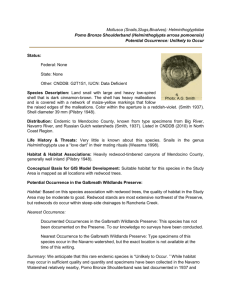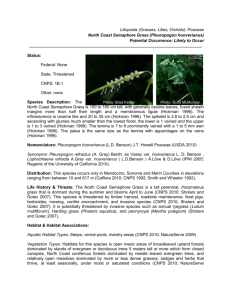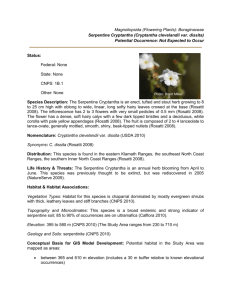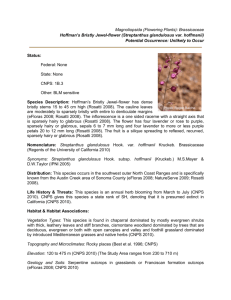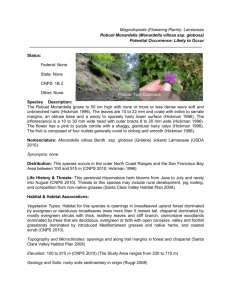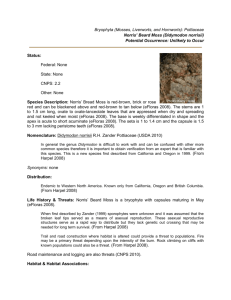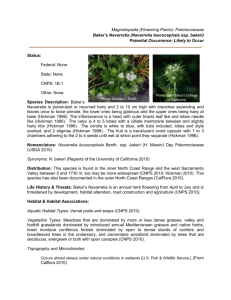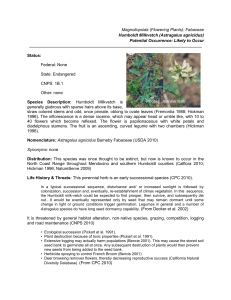GLGR Text
advertisement
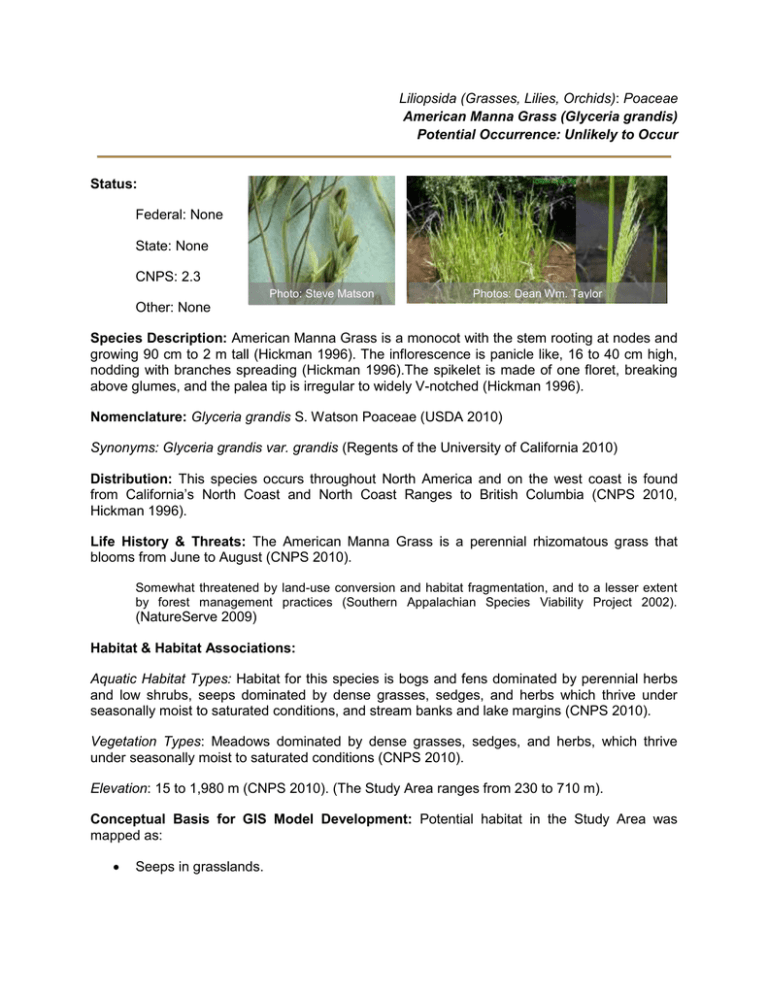
Liliopsida (Grasses, Lilies, Orchids): Poaceae American Manna Grass (Glyceria grandis) Potential Occurrence: Unlikely to Occur Status: Federal: None State: None CNPS: 2.3 Photo: Steve Matson Photos: Dean Wm. Taylor Other: None Species Description: American Manna Grass is a monocot with the stem rooting at nodes and growing 90 cm to 2 m tall (Hickman 1996). The inflorescence is panicle like, 16 to 40 cm high, nodding with branches spreading (Hickman 1996).The spikelet is made of one floret, breaking above glumes, and the palea tip is irregular to widely V-notched (Hickman 1996). Nomenclature: Glyceria grandis S. Watson Poaceae (USDA 2010) Synonyms: Glyceria grandis var. grandis (Regents of the University of California 2010) Distribution: This species occurs throughout North America and on the west coast is found from California’s North Coast and North Coast Ranges to British Columbia (CNPS 2010, Hickman 1996). Life History & Threats: The American Manna Grass is a perennial rhizomatous grass that blooms from June to August (CNPS 2010). Somewhat threatened by land-use conversion and habitat fragmentation, and to a lesser extent by forest management practices (Southern Appalachian Species Viability Project 2002). (NatureServe 2009) Habitat & Habitat Associations: Aquatic Habitat Types: Habitat for this species is bogs and fens dominated by perennial herbs and low shrubs, seeps dominated by dense grasses, sedges, and herbs which thrive under seasonally moist to saturated conditions, and stream banks and lake margins (CNPS 2010). Vegetation Types: Meadows dominated by dense grasses, sedges, and herbs, which thrive under seasonally moist to saturated conditions (CNPS 2010). Elevation: 15 to 1,980 m (CNPS 2010). (The Study Area ranges from 230 to 710 m). Conceptual Basis for GIS Model Development: Potential habitat in the Study Area was mapped as: Seeps in grasslands. While seeps are abundant in the Study Area, they are not available for mapping in the GIS database. Instead, we mapped grasslands. Note that no bogs or fens occur in the Study Area. Stream banks and pond margins Potential Occurrence in the Galbreath Wildlands Preserve: Habitat: American Manna Grass occupies open wet areas with dense vegetation, such as seeps in meadows, stream banks and lake margins. Potential habitat within the Preserve is scattered, but some areas may be good quality. While the potential habitat map (Figure 14) suggests that habitat is common, it overestimates appropriate areas: Only a fraction of the grassland areas contain seeps that are wet enough to support this species. Most of the tributaries to Rancheria Creek are heavily shaded and not expected to support the heavy herbaceous growth preferred by this species. The three ponds located on the southwestern Preserve boundary are the only areas that offer lake margin habitat. Some of these are heavily shaded. Habitat quality at some sites may, however, be moderate to good. Seeps are common in grasslands areas throughout the Preserve. The seeps are typically dominated by rushes (Juncus spp.), sedge (Cyperus eragrostis), mint (Menthe puleglum), bracken ferns (Pteridium aquilium), species which thrive under the same conditions as American Manna Grass. Nearest Occurrence: Documented Occurrences on the Galbreath Wildlands Preserve: Previous species list for the Galbreath Wildlands Preserve did not document this species (SSU Field Station and Nature Preserves 2010). Nearest Occurrence to the Galbreath Wildlands Preserve: American Manna Grass has not be documented south of Mendocino County in coastal California. In Mendocino County, it is known from a cluster of 8 occurrences (Calfora 2010) approximately 16 miles northwest of Preserve (Calflora 2010). Occurrence on the Preserve would constitute a southern and eastern range extension in coastal California. Summary: The American Manna Grass is “Unlikely to Occur” on the Preserve because, although habitat quality may be good at some sites, habitat is limited and occurrence at the Preserve would constitute a southern and eastern range extension for this species in coastal California. References Calflora. 2010. Information on California plants for education, research and conservation. <http://www.calflora.org/>.Accessed 2010 Jun 22. California Native Plant Society (CNPS). 2010. Inventory of Rare and Endangered Plants. Online edition, v7-10b. <http://www.cnps.org/inventory>. Accessed 2010 Jun 22. Hickman JC editor. 1996. The Jepson Manual Higher Plants of California.3rded.. London: University of California Press, Ltd. 1262 p. Matson S. 2008. Glyceria grandis. < http://calphotos.berkeley.edu/cgi-bin/img_query?reltaxon=contains&where-taxon=Glyceria+grandis>.Accessed 2011 Feb 27. NatureServe. 2009. NatureServe Explorer: An online encyclopedia of life. Version 7.1. <http://www.natureserve.org/explorer>. Accessed 2010 Jun 22. Regents of the University of California. 2010. The Jepson Online Interchange California Floristics. <http://ucjeps.berkeley.edu/interchange/> Accessed 2010 Jul 17. SSU Field Stations and Nature Preserves. 2010. Galbreath Wildlands Preserve Vascular Plant List. <http://www.sonoma.edu/preserves/docs/galbreath_vascular_plants.pdf>. Accessed 2010 Jun. Taylor DW. 2004. Glyceria grandis. American Mannagrass. < http://calphotos.berkeley.edu/cgibin/img_query?rel-taxon=contains&where-taxon=Glyceria+grandis>.Accessed 2011 Feb 27. United States Department of Agriculture (USDA). 2010. PLANTS Profile. <http://plants.usda.gov/java/profile?symbol=GLGR>. Accessed 2010 Jul 17. Species Account Description: Linden Schneider
